Physical Address
304 North Cardinal St.
Dorchester Center, MA 02124
Physical Address
304 North Cardinal St.
Dorchester Center, MA 02124
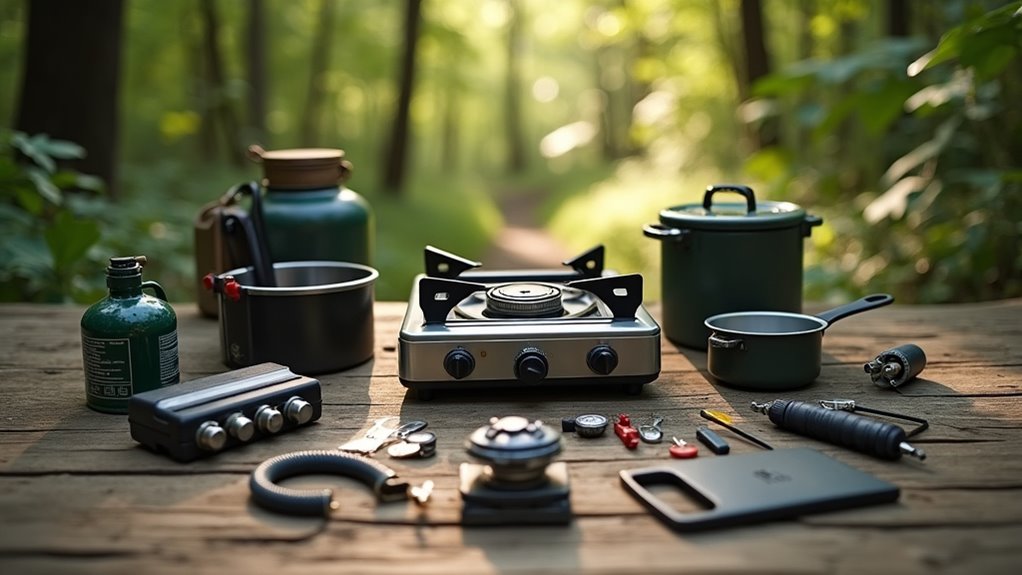
Perplexed about picking the perfect camping stove for your outdoor adventures? Discover 12 crucial factors that'll transform your wilderness cooking experience.
While a camping stove might seem like a simple piece of outdoor gear, it’s actually one of your most essential investments for wilderness adventures. You’ll need to weigh multiple factors, from fuel efficiency to weather resistance, before making your choice. Whether you’re a weekend warrior or a seasoned backpacker, understanding the key considerations will help you avoid common purchasing mistakes and select a stove that’ll serve you reliably when you’re miles from civilization.
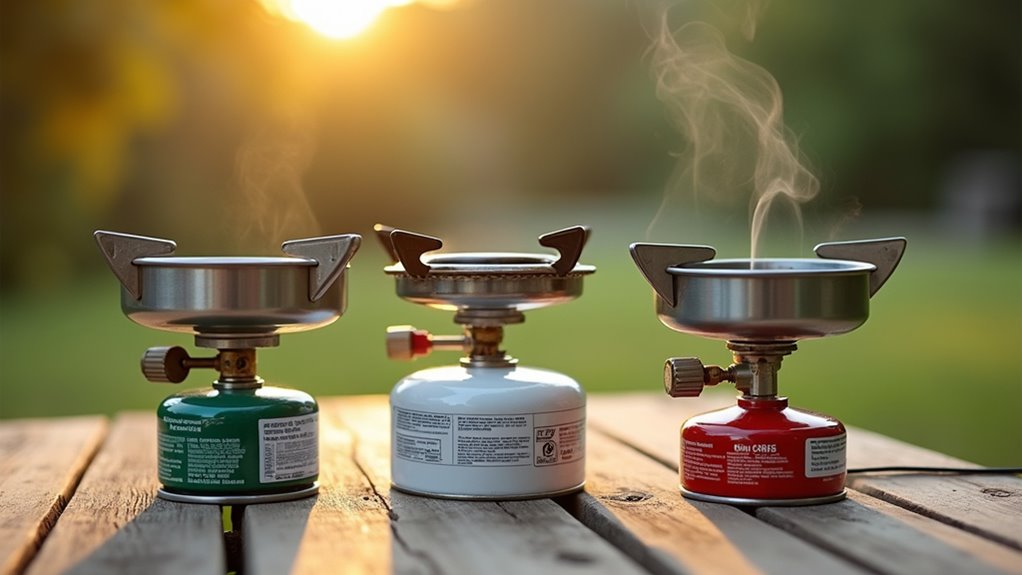
When choosing a camping stove, selecting the right fuel type can make or break your outdoor cooking experience. You’ll need to evaluate how and where you’ll use your stove to make the best choice.
Propane offers reliable performance in low temperatures and maintains high pressure, making it ideal for most camping situations. If you’re heading to colder climates or higher altitudes, contemplate stoves that use isobutane-propane mixtures for enhanced performance. These stoves offer excellent flame control and are typically lightweight and affordable.
While butane is convenient, it’s not your best choice for extreme conditions. For longer expeditions or international travel, liquid fuels like white gas or kerosene provide versatility, though they require priming. When selecting camping cookware, consider factors such as durability, weight, and ease of use to ensure a positive outdoor cooking experience.
Performance on the trail hinges on your stove’s ability to efficiently convert fuel into usable heat. When evaluating stoves, don’t rely solely on BTU ratings, as higher numbers don’t guarantee faster boiling. Instead, focus on documented boil times – efficient models can bring 2 cups of water to a rolling boil in under 3 minutes.
The Soto Windmaster stove consistently delivers fast boiling times across challenging outdoor conditions. Look for stoves with flames that wrap around your pot and consider using pots with heat exchangers or wider bases to reduce boiling time. Essential camping cooking gear can also make a significant difference in your meal preparation efficiency.
You should consider environmental conditions too – wind and altitude greatly impact performance. A good windscreen or built-in wind protection can make a substantial difference.
Remember that ideal fuel consumption balances quick boiling with efficiency – you don’t want to waste fuel with excessive flame settings when a moderate flame will do the job effectively.
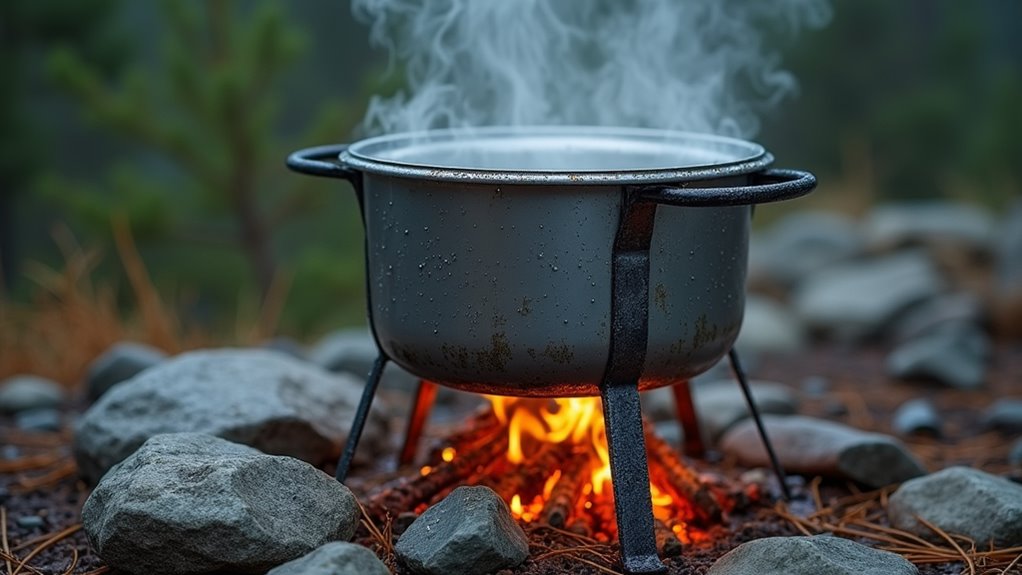
Since weather conditions can make or break your camping experience, choosing a stove that withstands environmental challenges is crucial.
Look for stoves with integrated windscreens and minimal exposed components, as they’ll perform better in gusty conditions. For cold-weather camping, opt for liquid gas stoves over propane/isobutane models, which can fail in extreme temperatures.
Consider the stove’s build quality and materials. You’ll want a sturdy pot stand, reliable ignition system, and high-quality seals to protect against moisture. The Camp Chef Everest 2X stands out with its excellent windscreen design and reliable performance in challenging conditions. Plus, it’s important to consider the fuel type compatibility of the stove with the environment and climate you’ll be camping in.
Check that your stove can handle altitude changes and high humidity, as these factors affect fuel efficiency. When testing, evaluate the stove’s performance in real-world conditions, including wind resistance and snow-melting capabilities.
Whether you’re backpacking through remote trails or car camping at a designated site, your stove’s weight and portability can greatly impact your outdoor experience.
Consider your specific mobility needs, as they’ll determine the most suitable stove type for your adventures. Essential camping gear can vary depending on the type of camping you plan to do.
When evaluating portable camping stoves, focus on these essential factors:
For backpacking, prioritize lightweight options, while car camping allows for heavier, more feature-rich stoves. The Snow Peak Home & Camp stove offers an excellent balance at just 3 pounds while maintaining powerful cooking capabilities.
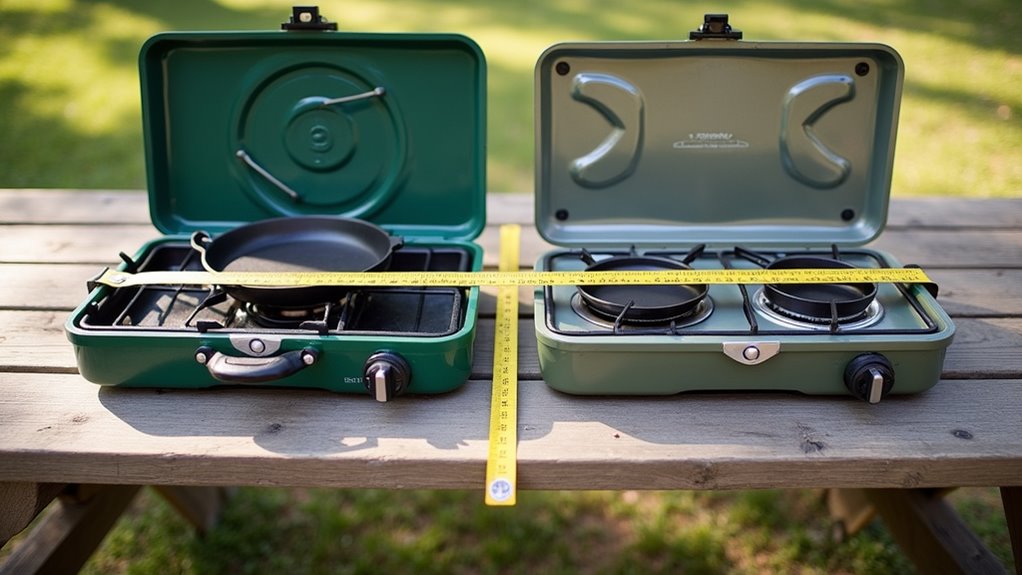
Three essential factors determine a camping stove’s cooking capacity: BTU output, burner configuration, and surface area. You should aim to match these features to your specific needs. Higher BTU ratings, like 30,000 per burner, deliver more powerful cooking capabilities for larger groups.
Matching your camping stove’s BTU output, burner setup, and cooking surface to your needs ensures optimal outdoor cooking performance.
When evaluating surface area, consider how you’ll use the stove. Multi-burner systems let you prepare several dishes simultaneously, while larger cooking surfaces accommodate bigger pots and pans. Having the right stove type can make cooking feel like less of a chore rather than drudgery. Mastering the art of camp cooking can also make your outdoor meals more enjoyable.
If you’re cooking complex meals, look for stoves with effective simmer control and adjustable burners. Don’t forget to factor in the windscreen’s effectiveness, as it helps maintain heat efficiency outdoors.
For extended trips or group camping, you might prefer a modular system that offers expandable cooking capacity while maintaining fuel efficiency.
When choosing a camping stove, setup time and maintenance requirements can greatly impact your outdoor cooking experience. Consider these key factors to make sure you select a stove that matches your needs:
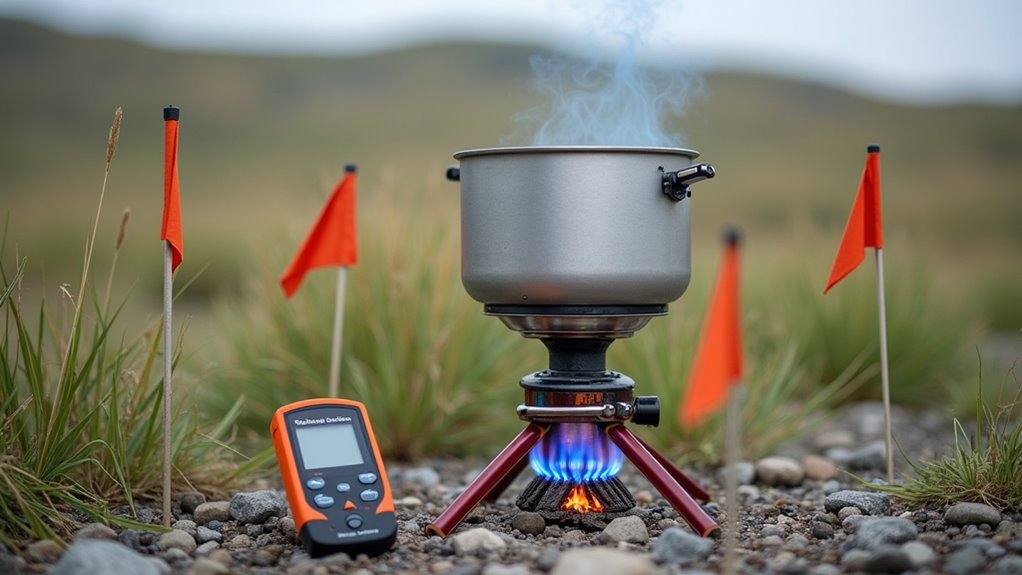
Since wind can dramatically affect your stove’s performance, understanding wind resistance and stability is crucial for reliable outdoor cooking.
Look for stoves with integrated windscreens or heat reflectors around burners, as they’ll greatly improve performance in gusty conditions. Well-designed pot supports that partially enclose the flame area offer additional protection without adding excess weight. A medium flame setting proves most efficient when cooking in moderate wind conditions.
You’ll want to take into account how wind impacts efficiency – it can increase boil times by 25-50% and consume more fuel. To combat this, choose stoves with flame stabilization technology and always use pot lids. Proper maintenance of your camping stove is also essential for safe and efficient use.
For stability, select models with wide, low-profile bases and anti-slip feet. The best designs include fold-out legs that provide solid contact with uneven surfaces. These features guarantee your stove remains steady and efficient, even in challenging outdoor conditions.
Mastering temperature control on your camping stove makes the difference between basic outdoor heating and true wilderness cooking. When evaluating a stove’s temperature control features, focus on precision valves and pressure regulation systems that maintain consistent performance in varying conditions.
Key aspects you should assess:
Remember that effective temperature control not only improves your cooking results but also enhances safety and fuel efficiency. Stoves with pressure regulators can maintain consistent heat output even as fuel levels decrease in the canister. Knowing how much camping cookware to bring can also impact your stove’s performance and fuel efficiency.
Advanced regulators and dedicated simmer controls will give you the precision needed for more sophisticated camp cuisine.
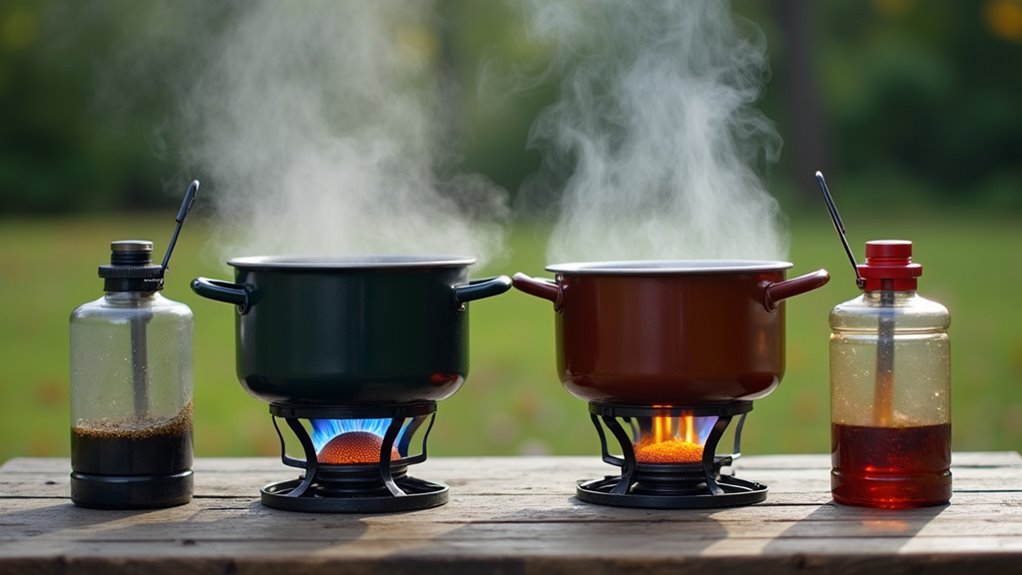
Accurate fuel calculations can make or break your camping experience, determining whether you’ll enjoy hot meals throughout your trip or run dry halfway through.
To calculate your needs, start by identifying your stove’s fuel consumption rate, typically measured in grams or milliliters per hour. You’ll find this in manufacturer specifications or user reviews.
Multiply your stove’s consumption rate by your average cooking time per meal, then factor in your daily meal count and trip duration. For example, if you’re cooking two 20-minute meals daily on a stove using 158g/hour, you’ll need about 53g per day. Cold temperatures can significantly increase your fuel usage, so plan accordingly in chilly conditions. Plus, essential camping cookware can impact your fuel efficiency.
Don’t forget to add a safety margin for unexpected conditions. You can optimize efficiency by using windshields, maintaining your stove properly, and matching the flame output to your cooking needs.
Safety should be your top priority when selecting a camping stove, as proper features and design can prevent accidents and guarantee worry-free outdoor cooking.
Prioritizing safety features in camping stove selection helps prevent accidents and ensures peaceful outdoor meal preparation.
When evaluating potential stoves, you should focus on critical safety elements that protect you and your fellow campers. Always ensure you read manufacturer instructions carefully before making a purchase decision.
Remember to choose stoves with replaceable components and easy-to-clean burners for long-term maintenance.
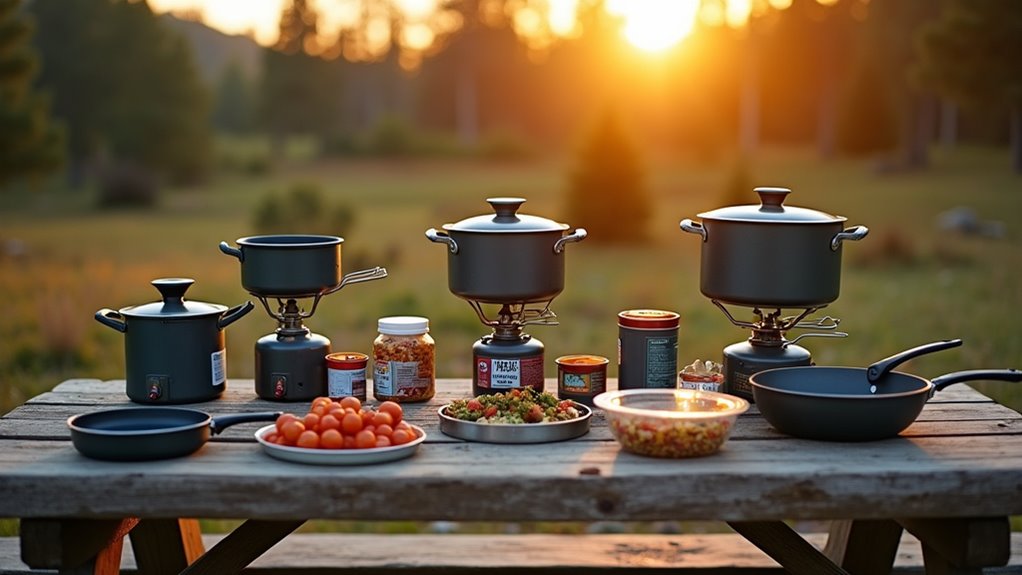
Selecting the right camping stove depends heavily on your cooking preferences and how long you’ll be in the wilderness. For short trips, you’ll find canister stoves ideal, as they’re easy to pack and operate. Make sure to consider models with wide pan supports to enhance stability during cooking.
However, if you’re planning extended adventures, consider liquid fuel or multi-fuel stoves, which offer refillable fuel bottles and versatile fuel options. Essential camping utensils are crucial for outdoor cooking fun and should be considered when selecting a camping stove.
If you’re camping where wood is plentiful and you’ll be staying in one location for a while, a wood-burning stove might serve you well.
For lightweight backpacking trips lasting just a few days, alcohol stoves provide a simple, cost-effective solution.
When planning longer expeditions or international travel, multi-fuel stoves are your best bet, offering reliability and the flexibility to use different fuel types available along your route.
When evaluating camping stoves, you’ll need to balance the initial purchase price against the long-term value of your investment. While basic models start around $75, premium options can exceed $250, and your choice should align with your camping frequency and needs.
The Jetboil Genesis model demonstrates how premium stoves can justify their higher costs through superior performance and efficiency. Consider these essential factors when determining long-term value:
Essential Camping Gear can also influence the long-term value of your camping stove purchase.
Choose a stove that matches your budget while considering these long-term value factors to make a smart investment.
Just as a compass guides you through wilderness trails, your camping stove choice steers your outdoor cooking experience. You’ll find that investing time in selecting the right stove—considering fuel type, efficiency, durability, and cooking capacity—pays off when you’re preparing hot meals in challenging conditions. Remember, a well-chosen stove isn’t just equipment; it’s your reliable partner in creating memorable wilderness dining experiences for years to come.